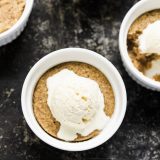Canadian cookbook author Tara O’Brady is the first to admit that self-saucing pudding cakes don’t start out pretty. But thanks to a bit of culinary magic, the end product is as impressive as it is elegant. “You put this thing in the oven that looks like sludge, and it comes out beautiful and with its own sauce,” she says.
Neither a custard nor a classic cake, self-saucing pudding cakes are made by placing a simple batter in oiled ramekins or a baking dish and carefully covering it with a sauce. As the cake cooks—sometimes it’s steamed but more often baked—the heat thins the sauce, allowing it to flow down the slippery sides of the ramekin. Meanwhile, the baking powder in the batter is activated, releasing carbon dioxide and causing the cake to rise. Within 15 minutes, the batter and sauce separate and switch places. The result is a delicate cake set above a pool of silky sauce.
The variations are endless—dark chocolate, lemon curd and caramel apple, to name a few—and they can be as simple as dusting uncooked batter with cocoa and sugar, then pouring a little water on top.
O’Brady, who was raised in Canada by Indian parents and an Anglophile grandmother, includes a pecan-inflected pudding cake in her cookbook, “Seven Spoons.” She grinds toasted nuts and combines them with all-purpose flour, brown butter, brown sugar, eggs, milk and vanilla to create a batter, which she also laces with 2 tablespoons of whiskey. The booze’s bite counteracts the brown sugar sweetness in her buttery sauce.
At Milk Street, we loved the marriage of pecans and whiskey, and O’Brady’s use of brown butter to reinforce the cake’s nuttiness. But we made several changes to add complexity and cut the sweetness.Replacing the brown sugar in the sauce with maple syrup added depth. We also tripled the amount of whiskey for more pronounced bite, splitting the liquor between the sauce and batter. For a sharp note to balance the sugars, we spiked the sauce with a teaspoon of cider vinegar.
Preparing the batter took just 20 minutes. First, we made the whiskey sauce, then we browned the butter. For the batter, we combined white sugar with milk, egg, vanilla and a little more whiskey. The pecans were processed until they turned into a coarse meal, which we mixed with baking powder, salt and slightly less flour than O’Brady’s recipe. The higher ratio of pecans enhanced the dessert’s overall nuttiness and resulted in a batter that baked up into an airy, moist-crumbed cake.
After dividing the batter into ramekins, we gently poured the prepared sauce over top. Within 30 minutes, we had four small cakes that were light, gooey and warm—and floating above a rich sauce. A spoon easily broke through the fluffy cake to the pool of sauce below.
“When you put it on the table, there’s gasps and sighs and it feels like a surprise,” O’Brady says. “How often are you able to do that?”




